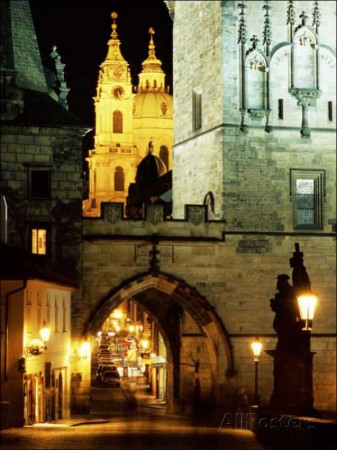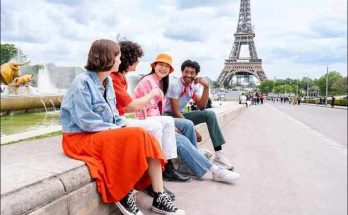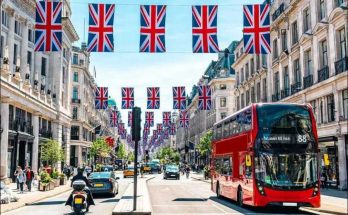The cappuccino to be drinked in Prague’s Grand Café Orient is utterly mediocre, and that’s okay.
This is because the point is really the situation, however, is quite impressive: the coffee is on the second floor of the House of the Black Madonna, originally built in 1912 as a department store in architect Czech Cubist Josef Gočár and as of 2003, houses the Museum of Czech Cubism in Prague, an architectural and design movement that emerged, flourished, and disappeared here in about 15 years.
Having been neglected for decades, the East has been restored in spring 2005 to its original splendor rigorously angle. Everything is a replica of what once was: a huge polished brass lamps and silk shade is suspended from the ceiling, glossy white-beams, decorated with geometric paneling surrounding the mirror bar is finished to a high gloss, the benches flanking the half-octagon tables are covered with a replica of the original trim green and white.
Once visited almost exclusively by scholars and fans of architecture, today, coffee is a stop on the card is marked on the list of more than a hippie and the tables around me are filled with beautiful young local and a handful of travelers. Unless their presence, the room is a capsule in near-perfect of a place that exists here and only here for a little over a decade ago almost a century.
This is why coffee-under is not a problem, since the promise of a cup is in perfect condition all around me in a number of Italian coffee from Starbucks or chain-like in the bustling Old Town. But the restoration of love for the East Grand Café and, equally importantly, the warm welcome he received from citizens of Prague to talk about something interesting: a renewed affection between the Czechs for their own heritage and traditions, whether or Bohemia in the 20th century.
And it’s a new sensibility, a change from previous years throughout the city, full-throttle embrace of foreign cultures and distant influences a concern that was perhaps expected in a country whose borders were open if abruptly in 1989. Expectations of travelers powered by the 90’s booming air transport phenomena increasingly affordable and proliferation of culture Wallpapers for a growing number of so-called jet-set-up has to include the right inalienable have, for example, pitch-perfect Northern Italian cuisine or an “it” bag (or a perfect cappuccino), no matter where on the planet, they have touched, to Prague developed by leaps and bounds to meet these expectations. The local and foreign entrepreneurs have taken crafty like to invest in this new European capital which evolved so promising. In 2001, the city has offered cappuccinos with shovels and even a little “it” bags, and for good measure, a magnificent new Four Seasons Hotel, located on the river Vltava with Michelin-starred restaurant Allegro (still the best in the city, serving the pitch-perfect northern Italy, natch).
After seeing their city to reach the traps of the world situation and destination, however, a handful of creative residents began mining in Prague own traditions of food, art, design, inspired architecture. And they have been subtly but effectively change the look and feel of the city since then.
One of the first to see the promise of the indigenous culture of Prague was Janek Jaros, who for nearly a decade has been a champion of Czech Cubism of his gallery of modern city. Set a bit incongruous among the gift shops and vendors syrupy Celetná garnet along a popular tourist route in the historic city of Prague modernist emporium original Czech design.
The fortysomething Jaros manufactures reproductions of furniture, kitchen utensils, and china by the Czech Cubist’s best-known such as Vlatislav Hofman, and Josef Pavel Janák Gočár (House of the Black Madonna), and sources for hard to find a handful of original chip clients, among them London’s Victoria & Albert Museum. But only in the last two to three years that its local clientele relatively recently trained and ready to invest in their own aesthetic traditions began to develop. “Modernism has changed significantly over the past three years, and therefore the market. We’ll get back to basics, working with locals and expatriates living in Prague in the long term.”
Jaros has recently collaborated with the designers of the Rocco Forte Collection hotel of 101 rooms Augustine, which had its much-heralded opening last May, helping to source products for interiors. Housed in a 13th century Augustinian monastery, spread over seven buildings in the picturesque district of Mala Strana, the hotel offers Olga Polizzi, Director of Design Collection, a chance to delve into the history of design in Prague. “What is unique about Czech cubism is that they pushed the ideas of Picasso and Braque beyond what the movement in Western Europe has been producing,” she said. “In Prague, Cubism became buildings , decoration, printing, textiles. This is a very important, perhaps the most important period in Czech art.”
Views: 410



